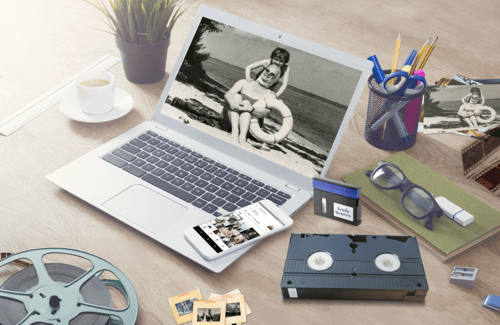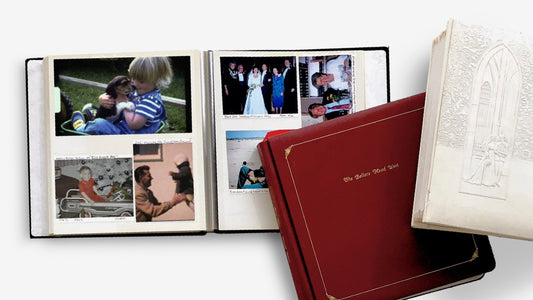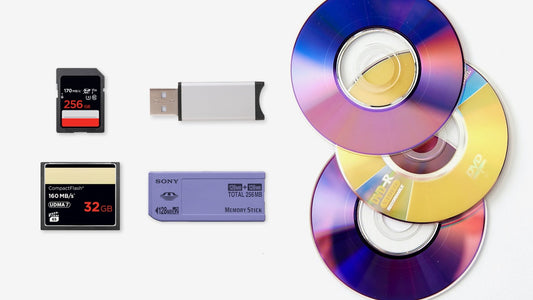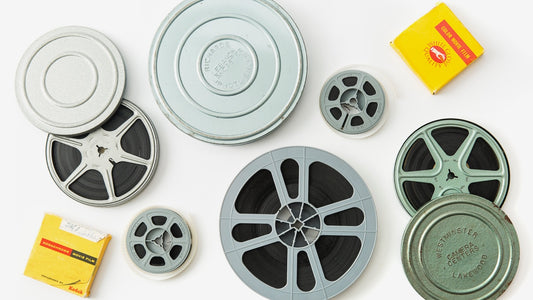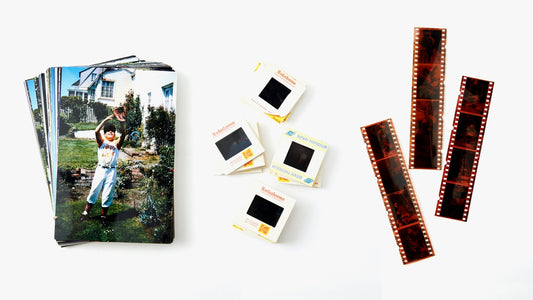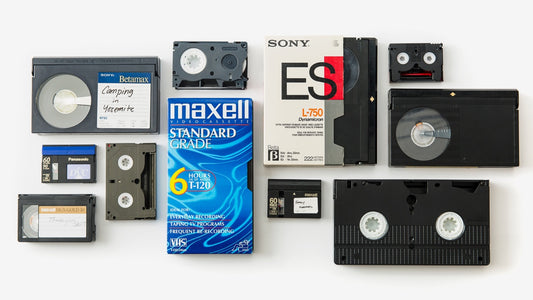If you've ever found a box of old photos, you've likely seen those mysterious strips of film tucked inside. Those are negative photos, and they are essential for preserving your family history. More than just faded relics, they are a tangible connection to your memories, capturing moments with incredible detail. This guide explains what negative photos are, why they're so important, and how you can preserve these precious pieces of your family's story. We'll also touch on their artistic potential and evolution. Let's uncover the secrets held within those simple strips of film.
Key Takeaways
- Preserve your family history by storing negatives properly. Keep them cool, dry, and dark, using archival-quality sleeves and boxes. This protects them from damage and ensures your memories stay vivid.
- Modernize your memories by digitizing your negatives. Scanning creates digital copies that are easy to share, edit, and preserve, safeguarding them from loss or damage. Services like YesVideo can help with this process.
- Negatives offer unique artistic opportunities. Explore creative techniques like image inversion or focus on negative space to add an artistic flair to your family photos and create truly unique keepsakes.
What Are Negative Photos?
Have you ever discovered a collection of old photo negatives tucked away in a forgotten box? These strips of film, often a confusing mix of orange and grey tones, hold a special place in preserving family history. They're more than just faded relics; they're a tangible connection to memories, capturing moments with unique detail. But what exactly are negative photos, and why are they so important?
What Makes a Photo a Negative?
A photographic negative is simply an image, usually on a transparent plastic strip (film), where light and dark areas are reversed. The bright parts of the original scene appear dark on the negative), and the dark parts appear light. Think of it as the inverse of the real-life image. This reversal is key to understanding how photographs were traditionally made. Negatives were the master copy, used to create positive prints.
How Light and Chemistry Create a Negative
This "opposite" look of negatives results from how film reacts to light. When you snap a picture with a film camera, light enters the lens and hits the film, which is coated with light-sensitive chemicals. Areas exposed to brighter light react more, causing them to darken. Areas exposed to less light stay lighter on the film. This creates the reversed image we see on a negative. It's like a secret code, waiting to be deciphered to reveal the true image. This process, while seemingly complex, underpins traditional photography and allows for multiple prints from a single negative.
How Do You Create Negatives?
Creating photographic negatives is a fascinating blend of art and science. It involves capturing light onto film and then using chemical processes to develop a reversed image—the negative—which you can then use to make prints. Let's explore the two key stages:
Getting the Right Exposure on Film
The journey of a negative begins with light. When you take a picture with a film camera, light enters through the lens and strikes the film. This film is coated with a light-sensitive emulsion containing silver halide crystals. When light hits these crystals, it forms a latent image—an invisible record of the light patterns. The amount of light reaching the film, determined by the exposure settings, is crucial. Correct exposure ensures the resulting negative has enough detail in both the highlights and shadows. Color negative film adds another layer of complexity. Its three emulsion layers are each sensitive to different colors of light (red, green, and blue), allowing the capture of a full-color image. Getting the right balance is key to a quality negative.
Developing Film: The Chemical Steps
Once the film has been exposed, the magic of chemistry takes over. The exposed film is developed using a series of chemical baths. The first bath, the developer, converts the latent image formed by light exposure into a visible image. It does this by transforming the exposed silver halide crystals into metallic silver, creating the dark areas on the negative. The stop bath halts the development process. Finally, a fixer removes the unexposed silver halide crystals, leaving a stable negative image unaffected by further light exposure. This entire process requires careful attention to timing and temperature, since these factors influence the final negative's density and contrast. Different film types and developing techniques can achieve specific looks, from high contrast to soft tones, adding an artistic dimension. Even alternative printing processes like cyanotype rely on these fundamental chemical processes to create stunning prints.
What Are the Different Types of Photo Negatives?
Negatives come in a few different forms, each with its own characteristics. Understanding these distinctions can help you appreciate the photographic process and how your family memories were captured. Let's explore the main types.
Understanding Black and White Negatives
Black and white negatives, created using black and white film, showcase a classic look. The magic lies in the reversal of light and dark areas. Dark areas on the negative correspond to the light areas in the final print, and vice versa. This contrast creates a timeless feel, capturing fine details and subtle shades of gray. Think of those iconic black and white portraits–the depth and drama often come from this interplay of light and shadow.
The Details on Color Negatives
Color negatives, produced on color film, introduce a fascinating twist. The colors are inverted, appearing as their complementary colors on the negative. A bright red in a photo shows up as cyan on the negative; green becomes magenta, and blue transforms into yellow. This inversion results from the chemical processes involved in color film development. When you send color negatives for digitization with a service like YesVideo, this color inversion is reversed, bringing your vibrant memories back to life.
The Purpose of the Orange Mask
If you've ever held a strip of color negatives up to the light, you've surely noticed its distinct orange tint. This isn't a sign of aging or a defect; it's an intentional and brilliant piece of chemical engineering. This orange "mask" is built directly into the film's layers to ensure accurate color reproduction. When creating a photographic print, the mask acts as a filter, automatically correcting for imperfections in the film's color dyes. Essentially, it provides a consistent base that helps balance the colors, ensuring the final print looks natural and true to life. Without it, your photos would likely have an unwanted blue or cyan cast, and the colors would not render accurately.
This orange base is also why simply scanning a color negative and inverting the colors on a computer doesn't produce a perfect image. The scanning software or equipment must be sophisticated enough to recognize and subtract this orange cast to reveal the true colors hidden beneath. This is where professional digitization makes a significant difference. When you have your negatives professionally digitized, specialized scanners and software are used to precisely remove the mask's influence, restoring the vibrant blues, greens, and reds from your original scene. This careful color correction is the key to transforming those orange-tinted strips into the beautiful, full-color digital memories you can cherish and share.
Slide Film: The Positive "Negative"
Slide negatives, also known as transparencies, are a unique type of positive film. Unlike traditional negatives, slide film captures the image in its original colors. These can be viewed directly when projected, offering vibrant and accurate color reproduction. Families often used them for presentations and sharing special occasions with a larger audience. Because slide film captures the image directly, the colors are often richer and more saturated than those from color negatives.
Common Film Formats You Might Find
As you sort through your family's collection, you'll likely encounter negatives in various shapes and sizes. Each format tells a story about the camera it came from and the era it represents. Recognizing them can feel like a small victory in your preservation project. Here are some of the most common types you might find.
135 Film (35mm)
This is the one you probably picture when you think of film. Known as 135 film or 35mm, this format was the go-to for decades, making it the most common type found in family photo collections. It’s a strip of celluloid film, 35mm wide, with sprocket holes running along the edges. Its widespread use in everything from professional cameras to simple point-and-shoots means it captured countless birthdays, holidays, and everyday moments. If you have a box of negatives, there's a very good chance it's filled with this popular film format, each strip holding a piece of your family's history.
110 and 126 Cartridge Film
If you find small, plastic cartridges, you've likely discovered 110 or 126 film. These formats were designed for convenience, making photography accessible to everyone. Introduced in the 1970s, 110 film, in particular, became a favorite for its use in compact, easy-to-load cameras perfect for casual snapshots. You simply dropped the cartridge in, and you were ready to go—no complicated threading required. Because they were so user-friendly, these cartridge-based films were often used to document family vacations and candid moments, preserving memories with charming simplicity.
120 Medium Format Film
Discovering 120 film, also known as medium format, is like finding a hidden gem. This film is wider than 35mm, resulting in a larger negative that captures incredible detail and richness. It was often favored by professional photographers and serious hobbyists for portraits, weddings, and other special events where image quality was paramount. Because of its superior resolution, digitizing these negatives can produce stunningly clear and detailed images that truly bring the past to life. If you have these in your collection, taking the step to preserve them digitally is well worth it to see your family’s most important moments in breathtaking clarity.
Disc and Large Format Film
While less common, you might also come across some unique formats like disc or large format film. Disc film, popular in the 1980s, is unmistakable—it’s a small, flat circular disc of film housed in a plastic cartridge, reminiscent of a mini vinyl record. On the other end of the spectrum is large format film, which includes any size larger than 4x5 inches. This was typically used by professional studio or landscape photographers for its exceptional detail. While you're less likely to find large format negatives in a casual family collection, discovering any of these specialty film formats is a fun look into the diverse history of photography.
Why Are Negatives Important?
Negatives often get overlooked in the age of digital photography, but they hold a special place in preserving family history. They're more than just strips of film; they're a tangible link to the past, offering a unique perspective on how we capture and cherish memories.
How Negatives Become Photographic Prints
Think of a negative as the master copy of your image. Light areas appear dark, and dark areas appear light—it's a photographic inverse. This unique characteristic is precisely what allows us to create prints. By shining light through the negative) onto photographic paper, we reverse the process, bringing your memories to life in a tangible form. The negative acts as a template, ensuring that every print accurately reflects the original scene. It's the foundation upon which your physical photos are built.
Understanding Contrast, Dynamic Range, and Film Grain
Negatives hold more visual information than you might realize, often capturing a wider range of detail than the final printed photo. This is thanks to a few key characteristics. First, negatives typically have lower contrast, meaning less difference between light and dark areas. This allows them to capture a broader spectrum of light and shadow, known as dynamic range. Proper exposure is what ensures all that precious detail—from bright skies to dark corners—is recorded on the film. Then there's film grain, the tiny dots you see when you look closely at a photograph made from a negative. This grain comes from the light-sensitive crystals in the film and gives the image a unique texture and character. When you digitize your negatives, you preserve all of this rich detail, ensuring the full story of your memories is saved.
Why Negatives Are Your Photo Archive
Negatives hold significant archival value. They're the original capture of a moment in time, containing more image data than a print. Historically, negatives were crafted on glass or even paper. Today, plastic film is the most common material. Regardless of the material, the negative remains the source, carefully stored to produce countless prints over time. This makes preserving your negatives crucial for maintaining the integrity of your family history. They're the raw, unedited record of your memories, offering a glimpse into the past that prints simply can't replicate. YesVideo understands this inherent value and treats every negative with the utmost care during our photo transfer process.
Connecting with Family Through Old Negatives
Beyond their technical importance, negatives have a profound emotional impact. They connect us to our family history in a tangible way. Holding a negative, you're holding a piece of the past, a direct link to the moment the photo was taken. Digitizing these negatives allows you to share these moments with future generations, creating a lasting legacy. It's more than just preserving memories; it's about sharing stories, sparking conversations, and fostering connections across generations. Digitizing and organizing family photos strengthens bonds and ensures that these precious memories remain alive and accessible for years to come.
How to Turn Your Negatives into Photos
Getting prints from your negatives involves a few different approaches. Let's explore two main paths: traditional darkroom techniques and modern digital scanning.
The Traditional Method: Darkroom Printing
Creating prints in a darkroom is the original method, offering a hands-on experience. It involves shining light through the negative onto photographic paper. The paper reacts to the light, darkening where the light shines through. This process reverses the negative image, resulting in a positive print. It's a bit like the science behind how film cameras work, just in reverse! While darkroom printing can be a rewarding hobby, it requires specialized equipment and knowledge. Historically, negatives were often made on glass plates, or even paper in the very early days of photography). Now, you're most likely working with negatives on plastic film.
The Modern Method: Scanning Your Negatives
These days, converting negatives to digital files is a popular and versatile choice. High-quality scanners can capture the detail from your negatives, creating digital images that you can then print at home or through a photo printing service. This method also makes sharing your photos online incredibly easy. Plus, having digital backups provides extra security for your precious memories. YesVideo's photo transfer service is a great option if you're looking for a professional and reliable way to digitize and preserve your photo negatives. Digitizing old photos and negatives is becoming increasingly important, offering a way to safeguard these fragile pieces of your family history. It's more than just preservation; it's about reconnecting with your past and sharing those special moments.
How to Preserve Your Photo Negatives
Negatives are a tangible link to the past, capturing precious family moments. But they're delicate and require specific care to last. Let's explore some practical steps to ensure your negatives remain in top condition for generations.
The Right Way to Store Your Negatives
Think of your negatives as tiny time capsules—they need a safe, stable environment. The ideal location is cool, dry, and dark, away from fluctuating temperatures and humidity. Avoid attics, basements, and garages, as these areas are prone to temperature swings and moisture. Instead, choose a climate-controlled area within your home, like a closet or drawer.
Archival-quality storage materials are key. Invest in acid-free sleeves and boxes designed for photographic negatives. These protective enclosures shield your negatives from dust, dirt, and chemical breakdown. Avoid using regular plastic bags or containers, as these can release harmful chemicals over time, damaging the film. Proper storage is the cornerstone of preserving your family history.
Choosing Archival-Safe Storage Materials
When it comes to protecting your negatives for the long haul, the materials you choose are incredibly important. You'll want to invest in storage supplies that are specifically labeled as "archival-safe" or "acid-free." This isn't just a fancy marketing term; it means the sleeves and boxes are made from materials that won't break down and release harmful chemicals. Regular plastic bags or cardboard boxes might seem convenient, but they can cause irreversible damage to your film over time. Since your negatives are the original source of the image—containing far more detail than a print—giving them this extra layer of protection is crucial. It's the best way to preserve the master copy of your memories.
Protecting Negatives from Light, Heat, and Humidity
Environmental factors significantly impact the longevity of your negatives. High temperatures and humidity can cause irreversible damage, leading to mold growth, color fading, and film deterioration. Ideally, aim for a storage environment with a consistent temperature below 70°F and relative humidity between 30-50%. Consider a dehumidifier if you live in a humid climate. This creates a stable environment for these irreplaceable memories.
Light exposure is another threat to negatives. Direct sunlight can fade images and cause discoloration. Store your negatives in opaque containers and avoid exposing them to bright light for extended periods. This preserves the image integrity and prevents fading. Protecting your negatives from these elements is crucial for their long-term survival.
Simple Tips for Handling Negatives Safely
Handling negatives requires a gentle touch. Always wear clean cotton gloves when handling film. The natural oils and acids on your skin can transfer to the negatives, causing smudges and fingerprints that are difficult to remove. Hold negatives by the edges, avoiding the image area.
Avoid bending or folding the negatives, which can create creases and cracks. If a negative curls, gently flatten it using a photo flattening tool or by placing it between two heavy, flat objects, like books. When viewing negatives, use a lightbox or a light table to illuminate the images without direct contact. Following these simple handling tips helps preserve your negatives for years.
How to Clean Negatives Before Storing
Before you tuck your negatives away for safekeeping, giving them a gentle clean can make a world of difference. Over the years, dust, smudges, and fingerprints can accumulate, and these imperfections not only degrade the film but will also appear in any future scans or prints. Cleaning negatives is a delicate task, so it’s important to be careful. You’ll need a few specific supplies: clean cotton gloves to protect from skin oils, an anti-static cloth to repel dust, and a bottle of 98% isopropyl alcohol. If the idea of cleaning them yourself feels a bit nerve-wracking, you can always rely on a professional service. At YesVideo, our technicians handle every negative with expert care during our negative transfer process to ensure your memories are preserved perfectly.
Once you have your supplies, you can begin. First, put on your gloves and always handle the negatives by their edges to avoid new fingerprints. Gently wipe away any loose dust with the anti-static cloth. For more stubborn smudges, apply a small amount of the isopropyl alcohol to a clean section of the cloth—never directly onto the negative—and wipe the film very gently from the center outwards. Let the negative air dry completely in a clean, dust-free space before putting it into a sleeve. Following these cleaning steps carefully will help you prepare your negatives for long-term storage or digitization, ensuring your family’s visual history remains as clear as the day it was captured.
A Guide to Digitizing Your Negative Photos
Negatives offer a glimpse into the past, capturing fleeting moments in time. But these fragile pieces of film are susceptible to damage and deterioration. Digitizing your negatives is the best way to safeguard these precious memories for generations to come. It’s like giving your family history a safety net.
The Advantages of a Digital Negative Archive
Think of digitizing your negatives as future-proofing your memories. Digital files are easily copied, shared, and backed up, unlike physical negatives that can fade or be lost. Plus, digital photos can be easily enhanced, edited, and shared online with family and friends near and far. Imagine rediscovering a faded photo of your grandparents and being able to restore it to its former glory—digitization makes this possible. It’s more than just preservation; it’s about bringing those memories back to life and reconnecting families with their history. Digitizing photos fosters those special bonds across generations.
How to Scan Negatives: Methods and Gear
You have a couple of options when it comes to digitizing your negatives. You can invest in a photo scanner designed to handle negatives, which gives you control over the process. These scanners come in a range of prices and capabilities, so you can find one that fits your budget and technical skills. Alternatively, you can use a professional photo digitization service like YesVideo. This is a great option if you have a large number of negatives or prefer to leave the technical aspects to the experts. YesVideo handles everything with care, ensuring your precious memories are preserved in the highest quality.
Using a Professional Service for High-Quality Scans
While DIY scanning is an option, entrusting your negatives to a professional service ensures your memories receive the best possible treatment. Services like YesVideo use high-quality, specialized scanners that capture incredible detail, creating versatile digital images you can easily print, share, and edit. This approach is especially valuable when you're dealing with fragile or irreplaceable family history. Instead of investing in equipment and learning the technical ropes, you can rely on experts who handle these delicate items every day. Using a professional photo transfer service offers peace of mind, knowing your precious negatives are being digitized with care and precision, safeguarding them for the future.
When to Digitize the Print Instead of the Negative
While negatives are the original source and typically yield the highest quality scan, there are times when digitizing the physical print is the better—or only—option. The most common reason is that the negative is lost, destroyed, or simply unavailable. In this case, the print is your only link to that memory. You might also choose to scan a print if it has unique sentimental value, like a handwritten note on the back or a special frame you want to capture. Ultimately, the goal is to preserve the memory. If the print is what you have, it’s absolutely worth digitizing to ensure that moment isn't lost to time.
Digitizing to Preserve Your Family History
Those old negatives aren't just pictures; they're portals to your family's story. They hold the memories, connections, and moments that shaped who you are today. By digitizing these snapshots, you're not just saving images—you're creating a tangible link to your past that future generations can cherish. Giving your family this window into their history is a priceless gift. You're weaving together the threads of your family's narrative, ensuring those stories are never forgotten.
Getting Creative: Artistic Uses for Photo Negatives
Beyond their practical uses, photo negatives offer unique artistic possibilities. Thinking outside the box with your negatives can lead to interesting visual effects and a fresh perspective on your family memories.
Using the Negative as a Final Art Piece
Negative space is the area surrounding the main subject of a photograph. It's not simply empty space—it's a crucial element of composition. A well-composed photo uses negative space to draw your eye to the subject and create balance. When looking at a negative, the negative space appears dark, while the subject is lighter. This offers a unique way to appreciate the composition and how the photographer framed the shot. For a deeper understanding of negative space, explore online photography guides.
Playing with Inverted Colors and Tones
One of the most striking artistic applications for negatives is image inversion. This involves reversing the colors and tones, essentially creating a positive image with inverted colors. This technique creates a surreal, dreamlike effect, transforming familiar faces and scenes into something new. With color negatives, the inversion process also reverses colors into their complementary colors—red becomes cyan, blue becomes yellow, and so on. This can produce unexpected and visually stunning results, giving new life to old family photos. You can find more information on negative photography and color inversion) online. Consider image inversion to add an artistic touch to your family history preservation project.
Creating "Digital Negatives" for Historic Processes
The concept of a "digital negative" brings a modern twist to preserving old memories. Think of it as a high-resolution digital scan of your original photo or film negative that becomes your new master copy. This digital file serves the same purpose as a traditional negative: it's the source from which you can create countless prints and share your images. It's particularly useful for exploring historic and alternative printing processes like cyanotype, allowing you to blend vintage aesthetics with modern convenience. By creating a digital negative, you're not just making a copy; you're building a durable archive. Services like YesVideo specialize in creating these high-quality digital files from your physical media, ensuring your family's visual history is protected from fading and decay, ready to be shared and reimagined for years to come.
How Photo Negatives Have Evolved
The Shift from Physical Film to Digital Files
Remember those little strips of film we used to get back from the photo developer? Those are negatives, a fascinating piece of photographic history. A negative is simply an image where the light and dark areas are reversed—bright parts of the original scene look dark, and dark parts look light. This principle remains the same whether we're talking about traditional film or digital images. While film negatives are less common these days, digital cameras and editing software can still create negative images. This shift to digital has given photographers incredible control over images, allowing for easy adjustments to colors and brightness. But even with these advancements, the core concept of the negative image—capturing a moment in inverted form—remains a fundamental part of photography's evolution. To learn more about the technical aspects of negative photography, take a look at this Wikipedia article).
Digital Editing vs. Physical Negatives
Digital photography offers incredible control, letting you easily adjust colors, brightness, and other elements in a way that physical negatives simply can't match. This flexibility allows you to restore faded memories and create beautiful, shareable images. When you digitize your negatives, you're not just preserving them; you're creating a versatile digital copy that's safe from loss or damage. On the other hand, the physical negative is the original master copy, holding more image data than any print. It’s a tangible link to your family's history, an authentic artifact from the moment the photo was taken. While digital editing provides convenience, the physical negative holds a unique historical significance that connects us directly to the past.
Why Film Negatives Still Matter
So, why are these little strips of film so important? Film negatives offer the highest possible image quality. Since prints made directly from the original negative maintain the most detail and clarity, they're the best way to preserve memories. Making copies from copies, especially with older photos, can lead to a noticeable loss of quality. This is why preserving your original negatives is crucial for protecting your family history—they're the purest record of those precious moments. Plus, understanding how negatives work—how the dark areas represent light and vice versa—gives you a deeper appreciation for the artistry and technical skill involved in traditional photography. For a simple explanation of why these inverted images are called "negatives," check out this helpful article. YesVideo's film transfer service can help you safeguard these irreplaceable memories by converting them to a safe, digital format. For a more in-depth look at the significance of negatives, this Reddit thread offers some great insights. Think of your negatives as the master copies of your memories—the key to preserving those images for generations to come.
Related Articles
Frequently Asked Questions
Why are my old photos and negatives orange and faded?
Over time, color dyes in photos and negatives can deteriorate, causing a shift in color balance, often appearing as a yellowish or orange tint. This is especially true for negatives and prints that weren't stored properly. Fading can also occur due to light exposure.
What's the difference between a negative and a print?
A negative is the original image captured on film. It shows a reversed image where light areas appear dark and dark areas appear light. A print is made from the negative, showing the image as it appeared in real life. Think of the negative as the master copy and the print as a reproduction.
Can I make prints from digital photos?
Absolutely! While digital photos don't involve negatives in the traditional sense, you can easily print them using a home printer, an online printing service, or a local photo lab. The quality of the print depends on the resolution of the digital image and the printing method used.
What's the best way to store my negatives long-term?
Keep your negatives in a cool, dry, and dark place. Ideally, use archival-quality, acid-free sleeves and boxes specifically designed for photo storage. Avoid storing them in attics, basements, or garages, as these areas are prone to temperature fluctuations and humidity.
Why should I digitize my old photos and negatives?
Digitizing creates a safe backup of your precious memories, protecting them from damage, loss, or deterioration. Digital files are also much easier to share with family and friends, and they can be enhanced or restored if needed. It's a great way to preserve your family history for future generations.





